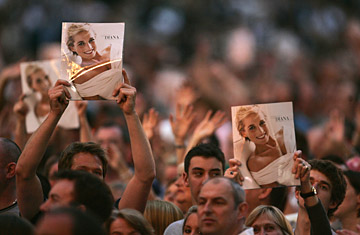
Fans wave posters during the Concert for Diana at Wembley Stadium, London, July 1, 2007.
A decade later, the memory of her remains, but how much else has changed. After the death of Diana, Princess of Wales, in 1997, Princes William and Harry (then aged 15 and 12, respectively) marched through central London, their little heads bowed, toward their mother's funeral. Today, with the sun shining bright on the day of a memorial service marking the 10th anniversary of her death, things couldn't have felt more different.
Loud cheers from the crowd got cheeky smiles and a wave from the same two Princes today as they made their way out of Guards Chapel, near Buckingham Palace, after the service. Elton John, who sang sad songs at Diana's funeral, strode out to the kind of applause he'd have been more used to on stage. Even Gordon Brown, as fresh a British Prime Minister as Tony Blair was when Diana was killed, got his own big cheer. (The cool Scot responded with a nod.)
This was a day of remembrance, yes, but not really a day of grieving. Unlike the flood of despair that poured forth in 1997, this time around there was barely a tear. Along the pavement towards Guards Chapel, some stared off into the distance, while others warbled to the hymns piped out over loud speakers from inside the service. Done with humming, "The Lord's My Shepherd," Londoner John Santos fondly remembered "an outstanding woman with a common touch." Showing up today, he said, was simply to make sure that "won't be forgotten."
Harry seconded that. "To us, just two loving children, she was quite simply the best mother in the world," the younger Prince said of his mother with the crowds outside now listening in silence. Losing her, he said, was "indescribably shocking and sad." But his message, met with applause, was clear: "She made us and so many other people happy. May this be the way that she is remembered."
A couple of miles down the road, in the gardens of Kensington Palace, Diana's old home, those memories were very much alive. If the crowd gathered at the chapel was reserved and respectful, this was the place for Union Jack-covered folding chairs — and a strong sense of many people's still very protective stake in Diana. Here, as one sign pinned to the Palace's thick, black, gilt-edged gates read, was "The People's Memorial." Depending where you looked, amid the pink paper hearts and purple balloons, Diana was "The People's Princess," "The Queen of Hearts" or "England's Rose."
Out of earshot of the royal family, this was also the place to deal in harsher, edgier thoughts. Rosemary, a Londoner in her 50s who declined to give her last name, insisted that Diana "got a raw deal." Another woman lamented her "appalling treatment from day one of her marriage." Laminated newspaper stories smearing Prince Charles were pinned to the gates. One banner, screaming "LONG LIVE THE QUEEN/DIANA FOREVER," was far less polite about Charles and Camilla, Charles' life-long love who is now his wife. The reason a decade hasn't dimmed Diana's memory, said a third woman, "is that she epitomized every facet of human frailty, and reached out in a very hostile world."
But you couldn't help feel life has moved on since 1997. Outside the chapel, joggers passed one way through the crowds, newspaper sellers another. In the gardens at Kensington, a handful of rugby players from England's national team were even running through drills ahead of next month's World Cup. The Princes, both fans of the game, would surely have smiled at that.
